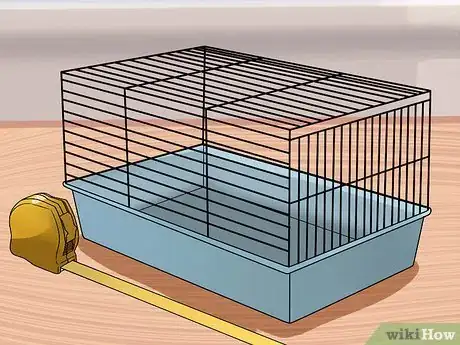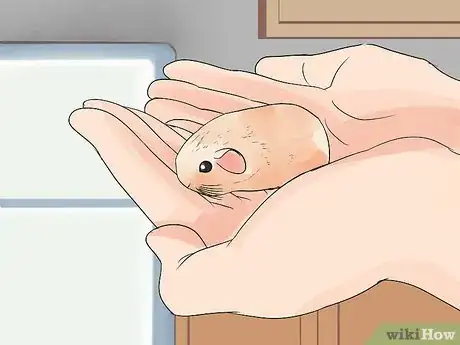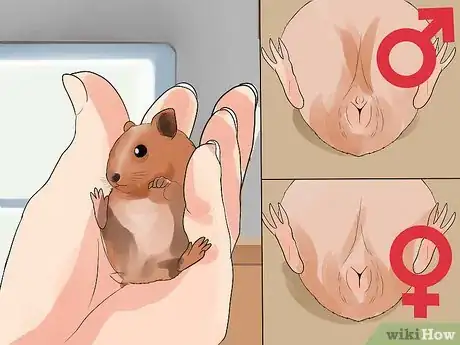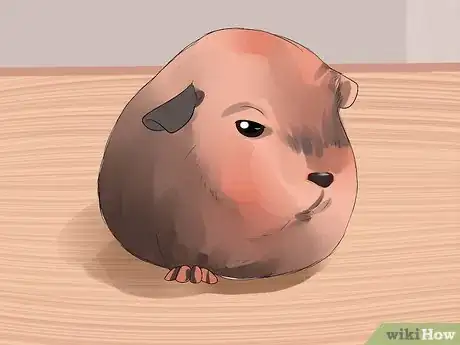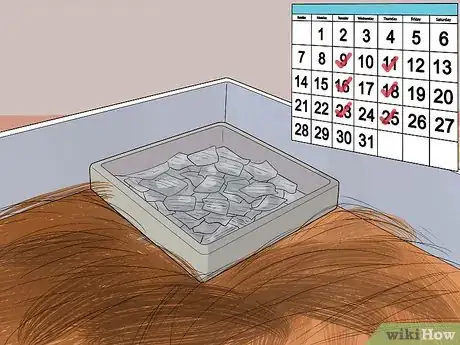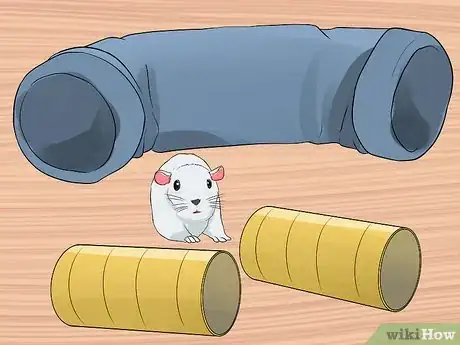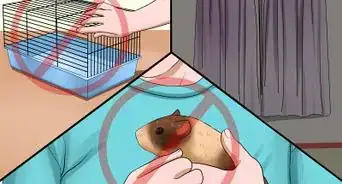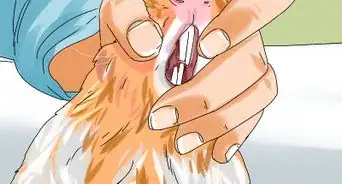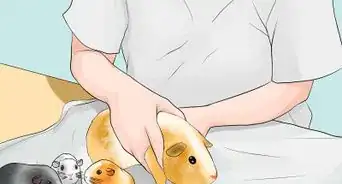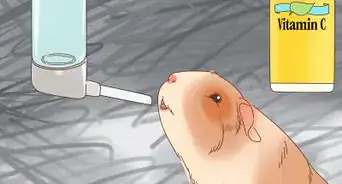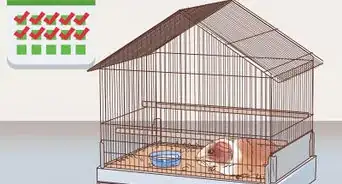This article was co-authored by Pippa Elliott, MRCVS. Dr. Elliott, BVMS, MRCVS is a veterinarian with over 30 years of experience in veterinary surgery and companion animal practice. She graduated from the University of Glasgow in 1987 with a degree in veterinary medicine and surgery. She has worked at the same animal clinic in her hometown for over 20 years.
There are 8 references cited in this article, which can be found at the bottom of the page.
wikiHow marks an article as reader-approved once it receives enough positive feedback. This article received 26 testimonials and 98% of readers who voted found it helpful, earning it our reader-approved status.
This article has been viewed 488,149 times.
Guinea pigs are cute and wonderful animals to keep as pets. Whether you purchase a baby guinea pig (pup) from your local pet store or have a female guinea pig at home that has recently given birth, you will need to know what is involved in properly caring for pups. When properly cared for and attended to, pups will grow up to become happy and healthy adults that will continue to make great pets.
Steps
Baby-Proofing Your Guinea Pig Cage
-
1Measure the size of your guinea pig cage. Pups will reach adult size very quickly, so it is recommended to have your pups in a cage that is an adequate size for an adult guinea pig. The cage should be at least 7.5 square feet. If you purchased pups from the pet store, make sure that the cage is large enough before you leave the store.[1]
- Even though the cage may seem a bit big for your pups, they will appreciate the extra space they will have to run and explore their environment.
- If you have a mother guinea pig in a cage with her babies, the cage should be large enough (minimum of 8 square feet) to accommodate all of them through the nursing stage.[2]
- If your current cage is not large enough, visit your local pet store for assistance in selecting the right size cage.
-
2Prevent your pups from escaping. The majority of guinea pig cages are built for adult guinea pigs.[3] For example, there is usually one-inch spacing between the bars on a guinea pig cage. Your pups could possibly be small enough to squeeze through this spacing. To prevent them from doing this, consider purchasing a cage that has a deeper pan at the bottom. The deeper pan would be more difficult for your pups to climb out of.[4]
- As an alternative to buying a new cage, you can purchase grids with smaller spacing at your local pet store. Secure the grids on the outside of the cage with cable ties.
Advertisement -
3Position the inverted plastic water bottle inside the cage. The water bottle should be positioned low enough so that your pups can comfortably reach and sip from the bottle's sipper tube.[5] You may need to reposition the water bottle several times before it's at just the right height for them. These water bottles can be purchased at your local pet store.
- The lowered water bottle may be too low for your pups' mom. If you see that she is struggling to sip from the water bottle, it may be helpful to place a second water bottle at a higher height for her.
-
4Place the cage in a quiet area of your house. This is important whether you are bringing home pups or caring for the ones that your female guinea pig has given birth to. Guinea pigs can be very sensitive to noise, so your pups will need to stay in a quiet area during their first few weeks of life.
Caring For Your Pups
-
1Handle your pups early and often. Pups should be held as early and often as possible so that they can become comfortable with human interaction. The more comfortable they are with people, the better socialized they will be, making them better pets. The mother guinea pig will not reject her babies if you hold them, but she will need time to complete the birthing process before they are ready to be held.[8]
- Female guinea pigs typically give birth to an average of three pups per litter. The birthing process usually takes about 30 minutes, with about three to five minutes between pups. You will know when the process is over when all pups have been delivered and the mother has eaten the placenta and cleaned the pups.
- In general, guinea pigs are not used to being held and may initially feel afraid when you pick them up. Getting your pups to be comfortable with you holding them may take some time.[9]
- To pick up one of your pups, slowly reach into the cage and reach for them from the front. Slide one of your hands under their chest and use your other hand to support their back end. Slowly pick them up and hold them against your chest for as long as they will let you. Talk to your pup with a gentle voice as you are handling them.[10]
- If the pup becomes squirmy when you are holding them, gently lower them back into their cage.
- Your pup may start to squeak when you take them away from his mom to hold them. Make sure not to keep them away from their mother for long.
- Do not try to handle your pups when they are sleeping or nursing.
-
2Determine the sex of your pups. If you purchased your pups from your local pet store, you probably will not need to determine whether they are male or female. If your adult female guinea pig gave birth, you can try to determine the sex of the babies soon after they are born. Female guinea pigs will have what looks like a tiny grain of rice in their genital area. Male guinea pigs will have a white ring in this area.
- It is recommended to have your veterinarian or a guinea pig expert determine the sex of your pups, if this has not already been done at the pet store.
-
3Separate the male pups from the female pups. If necessary, the male pups should be separated from their sisters and mother and moved to a different cage at the time of sexual maturity, which is around three to four weeks of age. This separation is necessary to prevent accidental pregnancies.
- Ideally, males should be moved to a different cage around three weeks of age. Female pups can stay with their mother until four weeks of age.[11]
- Guinea pigs are usually ready to begin leading more independent lives when they are around six weeks old, but you should still aim to separate them by three to four weeks of age if necessary.
-
4Learn what you should feed your pups. Pups generally eat the same thing as adult guinea pigs, so you do not need to feed a specialized baby diet. One exception is that pups need additional calcium in their first few weeks of life. The extra calcium will help their bones grow properly. Additionally, young, pregnant, or nursing Guinea Pigs need unlimited pellet food throughout the day. [12]
-
5Learn how to feed your pups. Feed your pups twice a day by placing small amounts of food in a sturdy food bowl. Remove any leftover food so that it does not spoil.[17] [18]
- Pups also need a constant supply of fresh water. Refill the plastic water bottle as needed and clean it with hot, soapy water once a week.[19]
- If the pups are still with their mother, they will start nursing within about 24 hours of birth and will continue nursing for about three weeks (before they reach sexual maturity). They will nurse from their mother during the first few days of life, then transition to solid food and mimic how their mother eats.[20] [21]
-
6Monitor your pups for sickness. Guinea pigs are susceptible to many types of diseases, such as heat stress, foot pad infections, and pneumonia. Because pups need a lot of vitamin C in their diet, a deficiency of this vitamin can cause a disease called scurvy. Signs of scurvy include swollen and painful joints, lack of appetite, and a reluctance to move.[22]
- If your pups are showing signs of scurvy, take them to the veterinarian for immediate treatment. Depending on the severity of the deficiency, your veterinarian may need to give your pups vitamin C injections.[23]
-
7Change the cage bedding regularly. The ideal bedding for your pups' cage consists of several inches of shredded paper or pine shed bedding. This bedding can quickly become soiled with leftover food and droppings. It may also become wet with drops of water from the water bottle. Change the bedding a minimum of twice a week to keep the cage clean.[24]
-
8Provide your pups with toys. Just like adult guinea pigs, pups love to play. Toys that your pup would enjoy include tunnels and ramps (if your cage is multi-level). Toys can be purchased at your local pet store, or you can make homemade toys out of items such as empty shoeboxes, empty milk cartons, and toilet paper rolls.
- You can also let your pups play outside of their cage. You will need to guinea pig-proof a room first to make the play area as safe as possible.
Expert Q&A
Did you know you can get expert answers for this article?
Unlock expert answers by supporting wikiHow
-
QuestionWhat do you feed newborn guinea pigs?
 Pippa Elliott, MRCVSDr. Elliott, BVMS, MRCVS is a veterinarian with over 30 years of experience in veterinary surgery and companion animal practice. She graduated from the University of Glasgow in 1987 with a degree in veterinary medicine and surgery. She has worked at the same animal clinic in her hometown for over 20 years.
Pippa Elliott, MRCVSDr. Elliott, BVMS, MRCVS is a veterinarian with over 30 years of experience in veterinary surgery and companion animal practice. She graduated from the University of Glasgow in 1987 with a degree in veterinary medicine and surgery. She has worked at the same animal clinic in her hometown for over 20 years.
Veterinarian
-
QuestionWhat happens if my guinea pig is sneezing?
 Pippa Elliott, MRCVSDr. Elliott, BVMS, MRCVS is a veterinarian with over 30 years of experience in veterinary surgery and companion animal practice. She graduated from the University of Glasgow in 1987 with a degree in veterinary medicine and surgery. She has worked at the same animal clinic in her hometown for over 20 years.
Pippa Elliott, MRCVSDr. Elliott, BVMS, MRCVS is a veterinarian with over 30 years of experience in veterinary surgery and companion animal practice. She graduated from the University of Glasgow in 1987 with a degree in veterinary medicine and surgery. She has worked at the same animal clinic in her hometown for over 20 years.
Veterinarian
-
QuestionAny special advice for caring for baby guinea pigs whose mom has abandoned them?
 Pippa Elliott, MRCVSDr. Elliott, BVMS, MRCVS is a veterinarian with over 30 years of experience in veterinary surgery and companion animal practice. She graduated from the University of Glasgow in 1987 with a degree in veterinary medicine and surgery. She has worked at the same animal clinic in her hometown for over 20 years.
Pippa Elliott, MRCVSDr. Elliott, BVMS, MRCVS is a veterinarian with over 30 years of experience in veterinary surgery and companion animal practice. She graduated from the University of Glasgow in 1987 with a degree in veterinary medicine and surgery. She has worked at the same animal clinic in her hometown for over 20 years.
Veterinarian Guinea piglets are born far more advanced than other small mammal babies. Try offering the orphan evaporated milk diluted 1:1 with water, and feed her from an eye dropper. Also put regular guinea pig kibble in but moisten it off with water, and offer some fresh vegetables shredded or chopped. Remember that the guinea pig doesn't have a mother to snuggle up to and keep warm, so make sure the nest is kept in a warm place.
Guinea piglets are born far more advanced than other small mammal babies. Try offering the orphan evaporated milk diluted 1:1 with water, and feed her from an eye dropper. Also put regular guinea pig kibble in but moisten it off with water, and offer some fresh vegetables shredded or chopped. Remember that the guinea pig doesn't have a mother to snuggle up to and keep warm, so make sure the nest is kept in a warm place.
References
- ↑ http://www.humanesociety.org/animals/guinea_pigs/tips/guinea_pig_housing.html
- ↑ http://www.guineapigmanual.com/guinea-pig-handling/
- ↑ http://animals.mom.me/handraise-baby-guinea-pigs-6520.html
- ↑ http://www.northstarrescue.org/pet-care-information/pet-guinea-pig-care/141-a-guide-to-pet-guinea-pig-cages
- ↑ http://animals.mom.me/handraise-baby-guinea-pigs-6520.html
- ↑ http://www.guineapigcorner.com/cages
- ↑ http://www.guineapigcorner.com/cages
- ↑ http://www.smallanimalchannel.com/critter-experts/guinea-pig/handling-rules-for-newborn-guinea-pigs-1108.aspx
- ↑ http://www.guineapigmanual.com/guinea-pig-handling/
- ↑ http://www.guineapigmanual.com/guinea-pig-handling/
- ↑ http://www.smallanimalchannel.com/critter-experts/guinea-pig/handling-rules-for-newborn-guinea-pigs-1108.aspx
- ↑ http://www.smallanimalchannel.com/critter-experts/guinea-pig/handling-rules-for-newborn-guinea-pigs-1108.aspx
- ↑ http://www.smallanimalchannel.com/critter-experts/guinea-pig/handling-rules-for-newborn-guinea-pigs-1108.aspx
- ↑ http://www.guineapigmanual.com/guinea-pig-handling/
- ↑ http://www.smallanimalchannel.com/critter-experts/guinea-pig/handling-rules-for-newborn-guinea-pigs-1108.aspx
- ↑ http://www.guineapigmanual.com/guinea-pig-handling/
- ↑ http://www.guineapigcorner.com/cages
- ↑ https://www.aspca.org/pet-care/small-pet-care/guinea-pig-care
- ↑ https://www.aspca.org/pet-care/small-pet-care/guinea-pig-care
- ↑ http://www.smallanimalchannel.com/critter-experts/guinea-pig/handling-rules-for-newborn-guinea-pigs-1108.aspx
- ↑ http://www.guineapigmanual.com/guinea-pig-handling/
- ↑ http://www.veterinarypartner.com/Content.plx?A=684
- ↑ http://www.veterinarypartner.com/Content.plx?A=684
- ↑ https://www.aspca.org/pet-care/small-pet-care/guinea-pig-care
- ↑ https://www.aspca.org/pet-care/small-pet-care/guinea-pig-care
- ↑ https://www.aspca.org/pet-care/small-pet-care/guinea-pig-care
About This Article
To care for baby guinea pigs, get a roomy cage and make sure they can't slip through the spaces between the bars. Feed the pups twice a day, provide a constant supply of fresh water, and handle them often so they can get comfortable with human interaction. Try to determine the sex of your pups as early as possible, then separate the males from the females when they reach 3-4 weeks of age to prevent accidental pregnancies! For tips on changing the cage bedding, read on!
